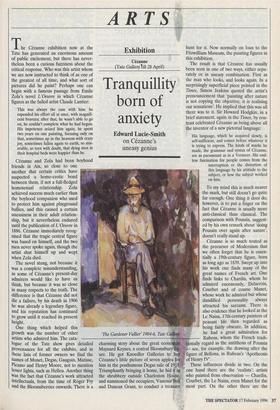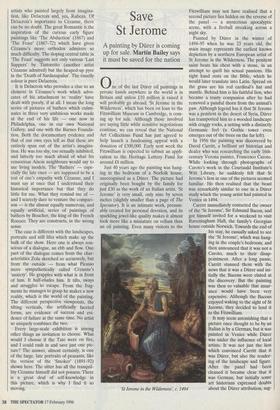ARTS
Exhibition
Cezanne (Tate Galleiyill 28 April)
Tranquillity born of anxiety
Edward Lucie-Smith on Cezanne's uneasy genius
The Cezanne exhibition now at the Tate has generated an enormous amount of public excitement, but there has never- theless been a curious fuzziness about the critical response. Who was this artist whom we are now instructed to think of as one of the greatest of all time, and what sort of pictures did he paint? Perhaps one can begin with a famous passage from Emile Zola's novel L'Oeuvre in which Cezanne figures as the failed artist Claude Lantier:
This was always the case with him: he expended his effort all at once, with magnifi- cent bravura; after that, he wasn't able to go on, he couldn't complete what he had begun. His impotence seized him again, he spent two years on one painting, focusing only on that, sometimes up in the heavens with crazy joy, sometimes fallen again to earth, so mis- erable, so torn with doubt, that dying men in their hospital beds were happier than he.
Cezanne and Zola had been boyhood friends in Aix, so close to one another that certain critics have suspected a homo-erotic bond between them, if not a full-fledged homosexual relationship. Zola achieved success much earlier than the boyhood companion who used to protect him against playground bullies, and this caused a certain uneasiness in their adult relation- ship, but it nevertheless endured until the publication of L'Oeuvre in 1886. Cezanne immediately recog- nised that the tragic central figure was based on himself, and the two men never spoke again, though the artist shut himself up and wept when Zola died.
The novel stung, not because it was a complete misunderstanding, as some of Cezanne's present-day admirers would like to have us think, but because it was so close in many respects to the truth. The difference is that Cezanne did not die a failure, by his death in 1906 he was already a legendary figure, and his reputation has continued to grow until it reached its present height. • One thing which helped this growth was the number of other artists who admired him. The cata logne of the Tate show gives detailed Provenances for all the exhibits, and in these lists of former owners we find the names of Monet, Degas, Gauguin, Matisse, Picasso and Henry Moore, not to mention lesser lights, such as Helleu. Another thing was the fact that Cezanne's work attracted intellectuals, from the time of Roger Fry and the Bloomsberries onwards. There is a The Gardener Vanier' 1904-6, Tate Gallery charming story about the great economist Maynard Keynes, a central Bloomsbury fig- ure. He got Knoedler Galleries to buy C,e'zanne's little picture of seven apples for him in the posthumous Degas sale of 1918. Triumphantly bringing it home, he hid it in the shrubbery outside Charleston House, and summoned the occupiers, Vanessa Bell and Duncan Grant, to conduct a treasure hunt for it. Now normally on loan to the Fitzwilliam Museum, the painting figures in this exhibition.
The result is that Cezanne has usually been seen in one of two ways, either sepa- rately or in uneasy combination. First as the man who looks, and looks again. In a surprisingly superficial piece printed in the Times, Simon Jenkins quoted the artist's pronouncement that 'painting after nature is not copying the objective, it is realising our sensations'. He implied that this was all there was to it. Sir Howard Hodgkin, in a brief statement, again in the Times, by con- trast celebrated Cezanne as being above all the inventor of a new pictorial language:
His language, which he acquired slowly, is self-sufficient, and comes before whatever it is trying to express. The kinds of marks he made, the grammar and syntax of azanne, are as paramount as in a Vermeer. His end- less fascination for people comes from the interruption or the distortion of this language by his attitude to the subject, or how the subject worked on him.
To my mind this is much nearer the mark, but still doesn't go quite far enough. One thing it does do, however, is to put a finger on the fact that Cezanne is usually more anti-classical than classical. The comparison with Poussin, suggest- ed by his own remark about 'doing Poussin over again after nature', doesn't really stand up.
Cezanne is so much touted as the precursor of Modernism that we often forget that he is essen- tially a 19th-century figure, born as long ago as 1839. Swept up into his work one finds many of the great names of French art. One finds links to Chardin, whom he admired enormously, Delacroix, Courbet and of course Manet, whose work he admired but whose dandified personality always attracted his sarcasm. There is also evidence that he looked at the Le Nains, 17th-century painters of peasant life then regarded as being fairly obscure. In addition, he had a great admiration for Rubens, whom the French tradi- tionally regard as the antithesis of Poussin — see, for example, the drawing after the figure of Bellona, in Rubens's 'Apotheosis of Henry IV'.
These influences divide in two. On the one hand there are the 'realists': artists who painted from observation — Charclin, Courbet, the Le Nains, even Manet for the most part. On the other there are the artists who painted largely from imagina- tion, like Delacroix and, yes, Rubens. Of Delacroix's importance to Cezanne, there can be no doubt. The great Romantic is the inspiration of the curious early figure paintings like 'The Abduction' (1867) and 'The Feast' (1867-72) which have given Cezanne's more orthodox admirers so much difficulty. The sloping central table in 'The Feast' suggests not only various 'Last Suppers' by Tintoretto (another artist Cezanne admired) but the heaped-up pyre in the 'Death of Sardanapalus'. The tinselly colour is pure Delacroix.
It is Delacroix who provides a clue to an element in Cezanne's work which advo- cates of his, attachment to 'reality' have dealt with poorly, if at all. I mean the long series of pictures of bathers which culmi- nates in three very ambitious works made at the end of his life — one now in Philadelphia, one in our own National Gallery, and one with the Barnes Founda- tion. Both the documentary evidence and that of our own eyes tell us that these are entirely spun out of the artist's imagina- tion. He was too shy, too sexually inhibited, and latterly too much afraid of what his censorious Aixois neighbours would say to use living models. The 'Bathers' — espe- cially the late ones — are supposed to be a test of one's empathy with azanne, and I must say at once that I understand their historical importance but that they do little for me. What they remind me of — and I scarcely dare to venture the compari- son — is the almost equally numerous, and equally artificial, series of paintings of bathers by Boucher, the king of the French Rococo. They are constructs, in the wrong sense.
The case is different with the landscapes, portraits and still lifes which make up the bulk of the show. Here one is always con- scious of a dialogue, an ebb and flow. One part of the dialogue comes from the char- acteristics Zola sketched so accurately, but from the outside — from what Picasso more sympathetically called Cezanne's 'anxiety'. He grapples with what is in front of him. It half-eludes him. It tilts, sways and struggles to escape. From the frag- ments he manages to grasp he makes a new reality, which is the world of the painting. The different perspective viewpoints, the tilting verticals, the artificially faceted forms, are evidence of success and evi- dence of failure at the same time. No artist so uniquely combines the two.
Every large-scale exhibition is among other things an invitation to choose. What would I choose if the Tate were on fire, and I could rush in and save just one pic- ture? The answer, almost certainly, is one of the large, late portraits of peasants, like the version of the 'Smoker' (1891-92) shown here. The sitter has all the tranquil- lity Cezanne himself did not possess. There is a great deal of self-knowledge in this picture, which is why I find it so moving.



























































 Previous page
Previous page